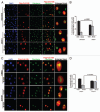The DNA damage effector Chk1 kinase regulates Cdc14B nucleolar shuttling during cell cycle progression
- PMID: 21301228
- PMCID: PMC3174002
- DOI: 10.4161/cc.10.4.14901
The DNA damage effector Chk1 kinase regulates Cdc14B nucleolar shuttling during cell cycle progression
Abstract
Chk1 is a critical effector of DNA damage checkpoints necessary for the maintenance of chromosome integrity during cell cycle progression. Here we report, that Chk1 co-localized with the nucleolar marker, fibrillarin in response to radiation-induced DNA damage in human cells. Interestingly, in vitro studies using GST pull down assays identified the dual-specificity serine/threonine nucleolar phosphatase Cdc14B as a Chk1 substrate. Furthermore, Chk1, but not a kinase-dead Chk1 control, was shown to phosphorylate Cdc14B using an in vitro kinase assay. Co-immunoprecipitation experiments using exogenous Cdc14B transfected into human cells confirmed the interaction of Cdc14B and Chk1 during cell cycle. In addition, reduction of Chk1 levels via siRNA or UCN-01 treatment demonstrated that Chk1 activation following DNA damage was required for Cdc14B export from the nucleolus. These studies have revealed a novel interplay between Chk1 kinase and Cdc14B phosphatase involving radiation-induced nucleolar shuttling to facilitate error-free cell cycle progression and prevent genomic instability.
Figures




Similar articles
-
Vertebrate cells genetically deficient for Cdc14A or Cdc14B retain DNA damage checkpoint proficiency but are impaired in DNA repair.J Cell Biol. 2010 May 17;189(4):631-9. doi: 10.1083/jcb.200910057. J Cell Biol. 2010. PMID: 20479464 Free PMC article.
-
Inhibition of human Chk1 causes increased initiation of DNA replication, phosphorylation of ATR targets, and DNA breakage.Mol Cell Biol. 2005 May;25(9):3553-62. doi: 10.1128/MCB.25.9.3553-3562.2005. Mol Cell Biol. 2005. PMID: 15831461 Free PMC article.
-
Differential roles of checkpoint kinase 1, checkpoint kinase 2, and mitogen-activated protein kinase-activated protein kinase 2 in mediating DNA damage-induced cell cycle arrest: implications for cancer therapy.Mol Cancer Ther. 2006 Aug;5(8):1935-43. doi: 10.1158/1535-7163.MCT-06-0077. Mol Cancer Ther. 2006. PMID: 16928813
-
The multiple checkpoint functions of CHK1 and CHK2 in maintenance of genome stability.Front Biosci. 2008 May 1;13:5016-29. doi: 10.2741/3060. Front Biosci. 2008. PMID: 18508566 Review.
-
Chk1 in the DNA damage response: conserved roles from yeasts to mammals.DNA Repair (Amst). 2004 Aug-Sep;3(8-9):1025-32. doi: 10.1016/j.dnarep.2004.03.003. DNA Repair (Amst). 2004. PMID: 15279789 Review.
Cited by
-
Perturbations at the ribosomal genes loci are at the centre of cellular dysfunction and human disease.Cell Biosci. 2014 Aug 19;4:43. doi: 10.1186/2045-3701-4-43. eCollection 2014. Cell Biosci. 2014. PMID: 25949792 Free PMC article. Review.
-
Multiple protein kinases influence the redistribution of fission yeast Clp1/Cdc14 phosphatase upon genotoxic stress.Mol Biol Cell. 2012 Oct;23(20):4118-28. doi: 10.1091/mbc.E12-06-0475. Epub 2012 Aug 23. Mol Biol Cell. 2012. PMID: 22918952 Free PMC article.
-
Cdc14b: a new player in aging.Aging (Albany NY). 2011 May;3(5):456. doi: 10.18632/aging.100332. Aging (Albany NY). 2011. PMID: 21666283 Free PMC article. No abstract available.
-
FBL promotes cancer cell resistance to DNA damage and BRCA1 transcription via YBX1.EMBO Rep. 2023 Sep 6;24(9):e56230. doi: 10.15252/embr.202256230. Epub 2023 Jul 25. EMBO Rep. 2023. PMID: 37489617 Free PMC article.
-
TORC1 inactivation promotes APC/C-dependent mitotic slippage in yeast and human cells.iScience. 2021 Dec 27;25(2):103675. doi: 10.1016/j.isci.2021.103675. eCollection 2022 Feb 18. iScience. 2021. PMID: 35141499 Free PMC article.
References
-
- Lam MH, Liu Q, Elledge SJ, Rosen JM. Chk1 is haploinsufficient for multiple functions critical to tumor suppression. Cancer Cell. 2004;6:45–59. - PubMed
Publication types
MeSH terms
Substances
Grants and funding
LinkOut - more resources
Full Text Sources
Research Materials
Miscellaneous
